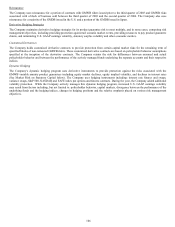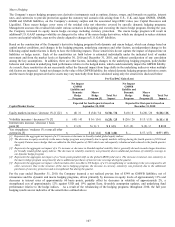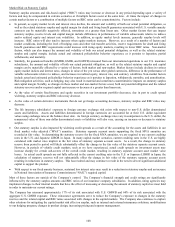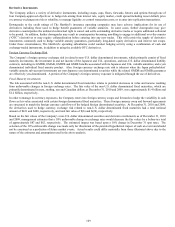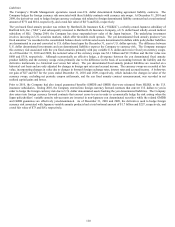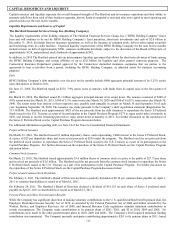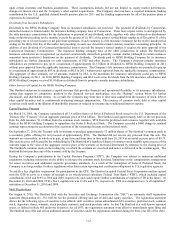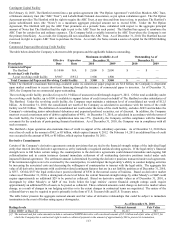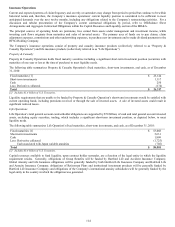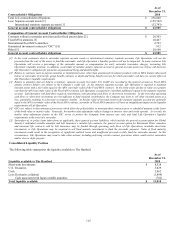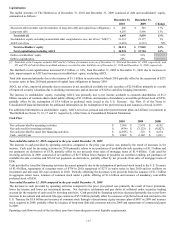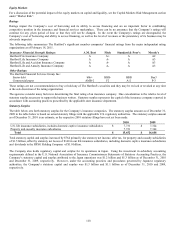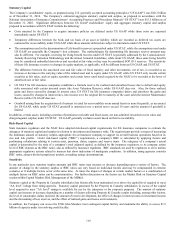The Hartford 2010 Annual Report Download - page 116
Download and view the complete annual report
Please find page 116 of the 2010 The Hartford annual report below. You can navigate through the pages in the report by either clicking on the pages listed below, or by using the keyword search tool below to find specific information within the annual report.
116
Off-Balance Sheet Arrangements and Aggregate Contractual Obligations
The Company does not have any off-balance sheet arrangements that are reasonably likely to have a material effect on the financial
condition, results of operations, liquidity, or capital resources of the Company, except for the contingent capital facility described above
and the following:
• The Company has unfunded commitments to purchase investments in limited partnerships, private placements and mortgage loans
of approximately $1.5 billion as disclosed in Note 12 of Notes to Consolidated Financial Statements.
The following table identifies the Company’ s aggregate contractual obligations as of December 31, 2010:
Payments due by period
Total
Less than
1 year
1-3
years
3-5
years
More than
5 years
Property and casualty obligations [1] $ 21,549 $ 5,732 $ 4,471 $ 2,857 $ 8,489
Life, annuity and disability obligations [2] 386,382 26,697 56,139 51,192 252,354
Operating lease obligations [3] 307 114 118 42 33
Long-term debt obligations [4] 19,799 901 1,280 1,610 16,008
Consumer notes [5] 419 79 250 50 40
Purchase obligations [6] 2,338 1,972 209 114 43
Other long-term liabilities reflected on the balance sheet [7] 1,848 1,357 345 146 —
Total [8] $ 432,642 $ 36,852 $ 62,812 $ 56,011 $ 276,967
[1] The following points are significant to understanding the cash flows estimated for obligations under property and casualty contracts:
• Reserves for Property & Casualty unpaid losses and loss adjustment expenses include IBNR and case reserves. While payments due on claim
reserves are considered contractual obligations because they relate to insurance policies issued by the Company, the ultimate amount to be paid
to settle both case reserves and IBNR is an estimate, subject to significant uncertainty. The actual amount to be paid is not finally determined
until the Company reaches a settlement with the claimant. Final claim settlements may vary significantly from the present estimates,
particularly since many claims will not be settled until well into the future.
• In estimating the timing of future payments by year, the Company has assumed that its historical payment patterns will continue. However, the
actual timing of future payments could vary materially from these estimates due to, among other things, changes in claim reporting and payment
patterns and large unanticipated settlements. In particular, there is significant uncertainty over the claim payment patterns of asbestos and
environmental claims. Also, estimated payments in 2010 do not include payments that will be made on claims incurred in 2010 on policies that
were in force as of December 31, 2009. In addition, the table does not include future cash flows related to the receipt of premiums that may be
used, in part, to fund loss payments.
• Under U.S. GAAP, the Company is only permitted to discount reserves for losses and loss adjustment expenses in cases where the payment
pattern and ultimate loss costs are fixed and determinable on an individual claim basis. For the Company, these include claim settlements with
permanently disabled claimants. As of December 31, 2010, the total property and casualty reserves in the above table are gross of a reserve
discount of $524.
[2] Estimated life, annuity and disability obligations include death and disability claims, policy surrenders, policyholder dividends and trail
commissions offset by expected future deposits and premiums on in-force contracts. Estimated life, annuity and disability obligations are based on
mortality, morbidity and lapse assumptions comparable with Life’s historical experience, modified for recent observed trends. Life has also
assumed market growth and interest crediting consistent with other assumptions. In contrast to this table, the majority of Life’s obligations are
recorded on the balance sheet at the current account values and do not incorporate an expectation of future market growth, interest crediting, or
future deposits. Therefore, the estimated obligations presented in this table significantly exceed the liabilities recorded in reserve for future policy
benefits and unpaid losses and loss adjustment expenses, other policyholder funds and benefits payable and separate account liabilities. Due to
the significance of the assumptions used, the amounts presented could materially differ from actual results.
[3] Includes future minimum lease payments on operating lease agreements. See Notes 12 and 14 of Notes to Consolidated Financial Statements for
additional discussion on lease commitments.
[4] Includes contractual principal and interest payments. All long-term debt obligations have fixed rates of interest. See Note 14 of Notes to
Consolidated Financial Statements for additional discussion of long-term debt obligations.
[5] Consumer notes include principal payments and contractual interest for fixed rate notes and interest based on current rates for floating rate notes.
See Note 14 of Notes to Consolidated Financial Statements for additional discussion of consumer notes.
[6] Includes $1.5 billion in commitments to purchase investments including about $693 of limited partnership, $99 of private placements and $729 of
mortgage loans. Outstanding commitments under these limited partnerships and mortgage loans are included in payments due in less than 1 year
since the timing of funding these commitments cannot be reliably estimated. The remaining commitments to purchase investments primarily
represent payables for securities purchased which are reflected on the Company’s consolidated balance sheet. In January 2011 the Company
executed an extension of its' existing information technology outsourcing arrangement with a third party vendor. This extension is effective
February 1, 2011 and runs through January 31, 2016. The approximate annual cost/outlay is $96 per year and is not included in the table above.
Also included in purchase obligations is $642 relating to contractual commitments to purchase various goods and services such as maintenance,
human resources, information technology, and transportation in the normal course of business. Purchase obligations exclude contracts that are
cancelable without penalty or contracts that do not specify minimum levels of goods or services to be purchased.
[7] Includes cash collateral of $1.1 billion which the Company has accepted in connection with the Company’s derivative instruments. Since the
timing of the return of the collateral is uncertain, the return of the collateral has been included in the payments due in less than 1 year.
Includes deposits and bank advances that were acquired through the purchase of Federal Trust Corporation in the second quarter of 2009.
Also included in other long term liabilities is $48 of net unrecognized tax benefits.
[8] Does not include estimated voluntary contribution of $200 to the Company’s pension plan in 2011.


